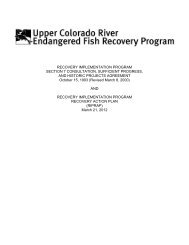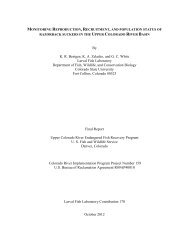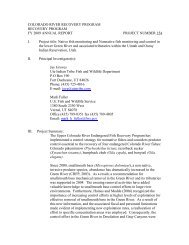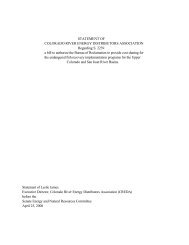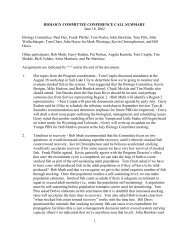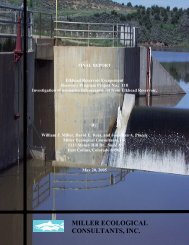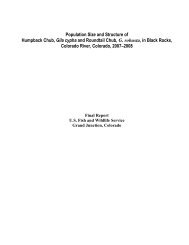3determining the degree <strong>of</strong> agency discretion in the operations <strong>of</strong> Federal water projects in othersubbasins that are subject to review <strong>for</strong> compliance with the Act or <strong>for</strong> the combination <strong>of</strong>recovery actions needed to achieve such compliance.The Service received three requests <strong>for</strong> initiation <strong>of</strong> section 7 consultation on the subject actionfrom the following <strong>of</strong>fices: 1) <strong>Bureau</strong> <strong>of</strong> Reclamation, Eastern Colorado Area Office (September24, 1999), 2) <strong>Bureau</strong> <strong>of</strong> Reclamation, Western Colorado Area Office (September 27, 1999), and3) Western Area Power Administration (October 15, 1999). The Service concludes that theimplementation <strong>of</strong> the recovery actions identified herein and all existing and some new depletions<strong>of</strong> water from the Upper Colorado River Basin above the confluence <strong>of</strong> the Gunnison River "mayaffect" the endangered Colorado squawfish 1 (Ptychocheilus lucius), humpback chub (Gila cypha),bonytail (Gila elegans), and razorback sucker (Xyrauchen texanus) and their critical habitat. TheService concludes that the subject action is not likely to adversely affect the bald eagle(Haliaeetus leucocephalus) or the southwestern willow flycatcher (Empidonax traillii extimus).In recent years, the number <strong>of</strong> wintering and nesting bald eagles have increased in the ColoradoRiver within the action area, with historic water depletions in place. It is not likely that any <strong>of</strong> theproposed actions will adversely affect bald eagles. The Service does not believe that historicwater depletions on the Colorado River have adversely affected the southwestern willowflycatcher because in many areas there is more habitat (riparian vegetation - willow, tamarisk,cottonwood) now than there was historically. Graf (1978) used photographic evidence, mapanalysis, and field surveys to show the spread <strong>of</strong> tamarisk throughout the Colorado River systemand described its effects <strong>of</strong> enlarging and stabilizing islands, bars, and restricting channel width.Many islands and shoreline habitats were not historically vegetated when spring flows were higherand prior to the establishment <strong>of</strong> tamarisk along the Colorado River.Consultation HistoryImplementation <strong>of</strong> the Endangered Species Act in the Colorado River Basin started with section 7consultation on Reclamation projects in the late 1970's. At this time, the Service determined thata jeopardy situation existed <strong>for</strong> the subject endangered fishes. Subsequently, the Act wasamended to direct Federal Agencies to work with State and local agencies to resolve waterresource issues in concert with conservation <strong>of</strong> endangered species.In 1984, the Department <strong>of</strong> the Interior, Colorado, Wyoming, Utah, water users, andenvironmental groups <strong>for</strong>med a coordinating committee to discuss a process to recover theendangered fishes while new and existing water development proceeds in the Upper ColoradoRiver Basin in compliance with Federal and State law and interstate compacts. After 4 years <strong>of</strong>negotiations, the Recovery Implementation Program <strong>for</strong> the Endangered Fish Species in theUpper Colorado River Basin was developed.1 The American Fisheries Society has changed the common name <strong>of</strong> this species to Coloradopikeminnow (Nelson et al. 1998), there<strong>for</strong>e, it will be referred to as the Colorado pikeminnow inthis document.
On January 21-22, 1988, the Secretary <strong>of</strong> the Interior; Governors <strong>of</strong> Wyoming, Colorado, andUtah; and the Administrator <strong>of</strong> the Western Area Power Administration cosigned a CooperativeAgreement to implement the Recovery Implementation Program <strong>for</strong> Endangered Fish Species inthe Upper Colorado River Basin (USFWS 1987). Current participants in the Recovery Programinclude: the Service, Reclamation, WAPA, Colorado, Utah, Wyoming, Environmental DefenseFund, The Nature Conservancy, Colorado Water Congress, Utah Water Users Association,Wyoming Water Development Association, and the Colorado River Energy DistributorsAssociation. The goal <strong>of</strong> the Recovery Program is to recover the listed species while providing<strong>for</strong> new and existing water development in the Upper Colorado River Basin. All participantsagreed to cooperatively work toward the successful implementation <strong>of</strong> a recovery program thatwill provide <strong>for</strong> recovery <strong>of</strong> the endangered fish species, consistent with Federal law and allapplicable State laws and systems <strong>for</strong> water resource development and use. Each signatoryassumed certain responsibilities in implementing the Recovery Program.In order to further define and clarify processes outlined in sections 4.1.5, 4.1.6, and 5.3.4 <strong>of</strong> theRecovery Program, a Section 7 Agreement and a Recovery Implementation Program RecoveryAction Plan were developed (USFWS 1993). The Agreement established a framework <strong>for</strong>conducting section 7 consultations on depletion impacts related to new projects and impactsassociated with existing projects in the Upper Basin. Procedures outlined in the Agreement areused to determine if sufficient progress is being accomplished in the recovery <strong>of</strong> endangered fishesto enable the Recovery Program to serve as a reasonable and prudent alternative to avoid thelikelihood <strong>of</strong> jeopardy and/or adverse modification <strong>of</strong> critical habitat. The Recovery Action Planwas finalized on October 15, 1993, and has been reviewed and updated annually.Since the implementation <strong>of</strong> the Recovery Program, over 200 biological opinions have been issuedon water depletions to the Upper Colorado River Basin. The Recovery Program andimplementation <strong>of</strong> the Recovery Action Plan have served as the reasonable and prudent alternative<strong>for</strong> these jeopardy opinions.On March 11, 1996, the Recovery Program’s Implementation Committee directed theManagement Committee to develop a strategy to provide and protect flows in the 15-Mile Reach<strong>of</strong> the Colorado River. The Service’s Regional Director then provided a letter (April 5, 1996) tothe chair <strong>of</strong> the Management Committee detailing the request from the ImplementationCommittee. The letter requested that the strategy contain a discussion <strong>of</strong> how the flow andnonflow activities in the Colorado River sub-basin work together. At the same time there werediscussions on whether the Section 7 Agreement was working in the 15-Mile Reach and onlegislation <strong>for</strong> long-term funding <strong>of</strong> recovery actions. The Management Committee <strong>for</strong>med aworkgroup to further identify the issues and recommend a strategy <strong>for</strong> their resolution. By theend <strong>of</strong> 1996, the workgroup recommended that the issues could be best resolved through abiological opinion on Recovery Program activities in the 15-Mile Reach. However, many issuesregarding flow needs, options <strong>for</strong> providing and legally protecting water, the importance <strong>of</strong>nonflow actions in recovering the fish, and a framework <strong>for</strong> conducting future section 7consultations remained unresolved. To resolve these issues, the State <strong>of</strong> Colorado convened a4
- Page 1 and 2: FINAL PROGRAMMATIC BIOLOGICAL OPINI
- Page 3 and 4: INCIDENTAL TAKE ...................
- Page 5: 2" Reclamation’s portion of 120,0
- Page 9 and 10: funding component of the Recovery P
- Page 11 and 12: 81. Habitat Protection ElementGener
- Page 13 and 14: Also, the Service and the Colorado
- Page 15 and 16: Table 1. The estimated benefits in
- Page 17 and 18: through recovery efforts that will
- Page 19 and 20: native fishes. Also, some species o
- Page 21 and 22: “new” depletions. This would in
- Page 23 and 24: Based on early fish collection reco
- Page 25 and 26: infrequent pulsed recruitment make
- Page 27 and 28: Area, in the Loma to Black Rocks re
- Page 29 and 30: 26Figure 1. Distribution of adult C
- Page 31 and 32: during high flows. Some of the pike
- Page 33 and 34: In the Upper Basin, above Glen Cany
- Page 35 and 36: 32Populations DynamicsThere are no
- Page 37 and 38: in low velocity shorelines and back
- Page 39 and 40: 36IMPORTANCE OF THE 15-MILE REACHTh
- Page 41 and 42: occur in the 15-Mile Reach). Provid
- Page 43 and 44: Applying the above regulations, the
- Page 45 and 46: in a river basin. While the model i
- Page 47 and 48: 44Factors Affecting Species Environ
- Page 49 and 50: 46To determine conditions with wate
- Page 51 and 52: 48140001200010000CFS800060004000200
- Page 53 and 54: 50CFS240002200020000180001600014000
- Page 55 and 56: 52CFS280002600024000220002000018000
- Page 57 and 58:
Release and protection of surplus H
- Page 59 and 60:
56CFS500045004000350030002500200015
- Page 61 and 62:
The formation of a variety of chann
- Page 63 and 64:
options will be determined through
- Page 65 and 66:
Passage at the Price-Stubb Diversio
- Page 67 and 68:
species. Recent population estimate
- Page 69 and 70:
the endangered fishes. Ongoing Reco
- Page 71 and 72:
68the Colorado pikeminnow, razorbac
- Page 73 and 74:
70There are no current population e
- Page 75 and 76:
additional reasonable and prudent m
- Page 77 and 78:
The Recovery Action Plan is an adap
- Page 79 and 80:
76actions have all been completed a
- Page 81 and 82:
78LITERATURE CITEDAbbott, C. C. 186
- Page 83 and 84:
80the Upper Colorado River Basin, P
- Page 85 and 86:
Kaeding, L. R., and D. B. Osmundson
- Page 87 and 88:
Minckley, W. L. 1983. Status of the
- Page 89 and 90:
Pitlick, J., and M. Van Steeter. 19
- Page 91 and 92:
Tyus, H. M., B. D. Burdick, R. A. V
- Page 93:
Wick, E. J. 1997. Physical processe



